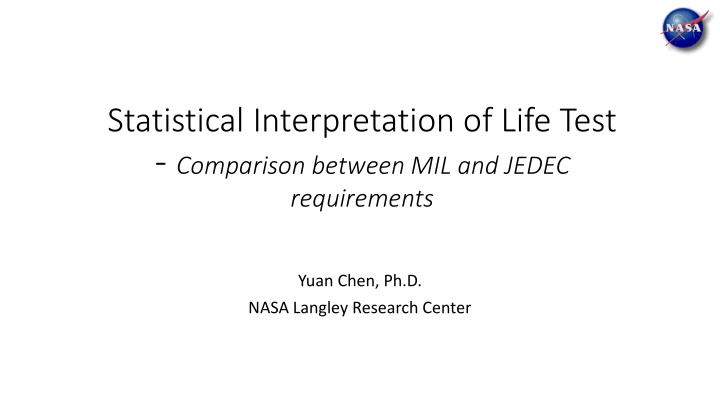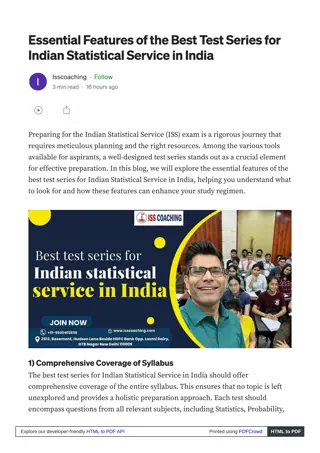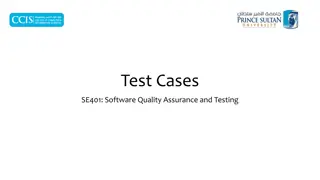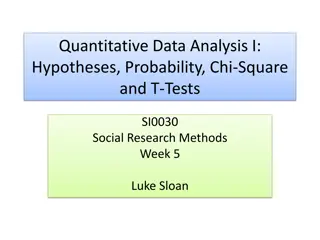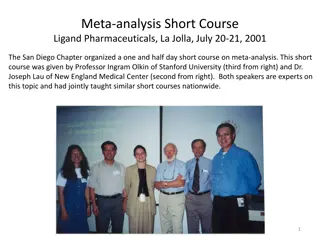Statistical Interpretation of Life Test
This presentation delves into the comparison between MIL and JEDEC requirements for semiconductor life tests, focusing on JEP001-1A, 2A, and 3A guidelines. It explores the significance of life test data, what it can demonstrate for reliability, and the importance of volume in testing. The content discusses foundry process qualification, wafer fabrication, and different levels of semiconductor technology qualification. It emphasizes the need for reliability testing to identify weaknesses and ensure the process meets application demands effectively.
Download Presentation

Please find below an Image/Link to download the presentation.
The content on the website is provided AS IS for your information and personal use only. It may not be sold, licensed, or shared on other websites without obtaining consent from the author.If you encounter any issues during the download, it is possible that the publisher has removed the file from their server.
You are allowed to download the files provided on this website for personal or commercial use, subject to the condition that they are used lawfully. All files are the property of their respective owners.
The content on the website is provided AS IS for your information and personal use only. It may not be sold, licensed, or shared on other websites without obtaining consent from the author.
E N D
Presentation Transcript
Statistical Interpretation of Life Test - Comparison between MIL and JEDEC requirements Yuan Chen, Ph.D. NASA Langley Research Center
Background Some contents were prepared (but didn t go through) for EEE Parts 101 training at MSFC in December 2022. Some thoughts were triggered during the NESC COTS assessment. Would not consider as a complete training or tutorial package, but for sharing and discussion purpose. Focus or use semiconductor parts as an example 6/15/2023 2023 NEPP Electronics Technology Workshop (ETW) 2
Outline JEP001-1A, 2A and 3A Foundry Process Qualification Guidelines for semiconductor Life Tests in MIL-STD and JEDEC Standards 45 parts for 1000 hours and 3 lots with 77 parts from each lot for 1000 hours Assumptions Constant failure rate Exponential Distribution What does life test data mean? What a life test can demonstrate for ? What a life test can demonstrate for lifetime or reliability? Volume matters Different philosophy Different processes 6/15/2023 2023 NEPP Electronics Technology Workshop (ETW) 3
JEP001-1A, 2A and 3A (I) Foundry Process Qualification Guidelines Wafer Fabrication Manufacturing Sites Provide methodologies for the minimum set of measurements to qualify a new semiconductor wafer process .. with particular reference to a generic silicon-based CMOS logic technology. 1A Backend of Line 2A Front End Transistor Level 3A Product Level (part-level) Describe backend-level, transistor-level or package-level test and data methods for the qualification of semiconductor technologies. 6/15/2023 2023 NEPP Electronics Technology Workshop (ETW) 4
JEP001-1A, 2A and 3A (II) Does not give pass or fail values or recommend specific test equipment, test structures or test algorithms. Two levels of qualification Level 1 - pure process qualification intended to find reliability weaknesses. Primarily addresses technology wear-out mechanisms through packages or wafer level reliability tests on specially designed test structures. Level 1 qualification report qual plan, description of the test vehicle including test structure features and dimensions, summary of test methods used, pass/fail criteria, and test results, analysis and model parameters. Level 2 demonstrates the reliability of the process that corresponding to the reliability demands from projected or known applications. Can be implemented via the testing of a relevant functional technology qualification vehicle (TQV), including life test. Level 2 qualification report qual plan, description of TQV, test description and specification, pass/fail criteria, test results & analysis including failure analysis and FA results. 6/15/2023 2023 NEPP Electronics Technology Workshop (ETW) 5
JEP001-1A, 2A and 3A (III) Provide references for each test 1A Backend of line testing Electromigration (EM), Stress Migration (SM) or Stress-Induced Voiding (SIV), Thermal Cycling (TC), Inter/Intra Metal-Dielectric Reliability (IMD), Yield Data & Defect Density Calculation 2A Transistor-level testing Time-Dependent Dielectronic Breakdown (TDDB), Voltage Ramp Dielectronic Breakdown (VRDB)/Charge to Breakdown (QBD), Hot Carrier Injection (HCI), Bias Temperature Instability (BTI), Plasma Process Induced Damage (P2ID), Ionic Contamination/Bias Temperature Stress (BTS), Ionic Contamination/Triangular Voltage Sweep (TVS) 3A Product-level testing Early Life Test, Long Term Life Test (HTOL), Temperature Cycling (TC), Temperature Humidity Bias (THB) or Highly Accelerated Stress Test (HAST), ESD characterization, Latch-up characterization, Process Control Monitor (PCM), Construction Analysis (CA) 6/15/2023 2023 NEPP Electronics Technology Workshop (ETW) 6
Life Test 6/15/2023 2023 NEPP Electronics Technology Workshop (ETW) 7
Life Tests in MIL-STD Standards MIL-STD-883K, Method 1005.10 Steady-State Life The steady-state life test is performed for the purpose of demonstrating the quality or reliability of devices subjected to the specified conditions over an extended time period. Life tests conducted within rated operating conditions should be conducted for a sufficiently long test period to assure that results are not characteristic of early failures or "infant mortality, . Sampling: MIL-PRF-38535 General Specification for Integrated Circuits (Microcircuits) Manufacturing , Appendix D Table D-I Sample sizes are based upon the Poisson exponential binomial limit. Minimum size of sample to be tested to assure with a 90 percent confidence that a lot having percent-defective equal to the specified sample size series value will not be accepted (single sample). 45 parts for 90% confidence with < 5% defective allowable testing for 1000 hours at 125C. 6/15/2023 2023 NEPP Electronics Technology Workshop (ETW) 8
Life Tests in JEDEC Standards JEDEC Standard, JESD47I, Stress-Test-Driven Qualification of Integrated Circuits HTOL (high temperature operating life) - The duration listed here is generally acceptable to qualify for the given application level. However, it does not necessarily imply the demonstrated of the lifetime requirements for a particular use condition. It depends on failure mechanisms and application environments. Sampling in Table A 3 lots with 77 sample per lot for 1000 hours w/o failure. 6/15/2023 2023 NEPP Electronics Technology Workshop (ETW) 9
Assumptions -- important to remember or verify Exponential distribution is typically assumed when estimating the failure rate using life test data. Bottom portion of bathtub curve or constant failure rate. Upper bound if actual failure rate is decreasing. The analysis/data on the following slides assume no failure has occurred during life test. The same methodology applies to cases when there are failures during life test. The failure rate, lifetime and reliability estimates on the following slides are for the testing condition. An activation energy needs to be used to translate to a use condition. 6/15/2023 2023 NEPP Electronics Technology Workshop (ETW) 10
Exponential Distribution Probability density function ? ? = ?? ?? Cumulative distribution function F ? = 1 ? ?? failures per unit of time Mean Time to Failure = 1/ Time with a percentage tx% t50%: time when 50% of parts fail corresponding to Median Time to Failure = ln(2)/ t5%: time when 5% of parts fail t1%: time when 1% of parts fail Reliability is R ? = ? ?? t50%: time at reliability is 50% t5%: time at reliability is 95% t1%: time at reliability is 99% 6/15/2023 2023 NEPP Electronics Technology Workshop (ETW) 11
Estimation estimation Point estimate An interval around that has a high degree of confidence of enclosing the true value of , called confidence interval 90% (a percentile) confidence interval means Same experiment repeated many times Same estimation method used to estimate the interval for 90% of these intervals would contain the true For zero failures, upper limit for is ?100(1 ?)= ln ? 100(1- ) is the upper percentile, n is sample size, T is the testing hours ?? 6/15/2023 2023 NEPP Electronics Technology Workshop (ETW) 12
What a life test can What a life test can demonstrate for ? demonstrate for ? 1000000 Blue 45000 device-hours w/o failure Green 231000 device- hour, i.e., 3x77 parts under 1000 hours w/o failure Using ?100(1 ?)= ln ? upper bound as a function of bound percentile Lamda Upper Bound (FIT) 100000 10000 ?? 1000 50 60 70 80 90 100 Bound Percentile (%) 6/15/2023 2023 NEPP Electronics Technology Workshop (ETW) 13
What a life test can What a life test can demonstrate for lifetime demonstrate for lifetime or reliability? or reliability? Bound Percentile Demostrated Life at Testing Condition t50% (yrs) 5.14 3.89 2.21 1.55 1.19 0.97 0.77 26.38 19.95 11.36 7.94 6.1 4.95 3.97 t10% (yrs) 0.78 0.59 0.34 0.24 0.18 0.15 0.12 4.01 3.03 1.73 1.21 0.93 0.75 0.6 t5% (yrs) 0.38 0.29 0.16 0.11 0.09 0.07 0.06 1.95 1.48 0.84 0.59 0.45 0.37 0.29 50 60 80 90 95 97.5 99 50 60 80 90 95 97.5 99 Blue highlighted - 45000 device-hours w/o failure Red numbers - MIL-PRF-38535 Appendix D Table D-I 45 parts - 90% confidence with < 5% defective allowable, i.e., at least 95% of parts will pass 1000 hours or 0.11 years. 22 parts - 90% confidence with < 10% defective allowable, i.e., at least 95% of parts will pass 2045 hours or 0.24 years Green highlighted 231000 device- hour, i.e., 3x77 parts under 1000 hours w/o failure 6/15/2023 2023 NEPP Electronics Technology Workshop (ETW) 14
What a life test can demonstrate? The answer to this question is associated with confidence level, reliability and an activation energy assumed. The implementation of any life test plan is also associated with cost of the electronic parts as well as testing time needed. When projects have different target mission life, different requirement on confidence level, reliability requirement and different restraints on cost and testing time, different life test plans are needed. 6/15/2023 2023 NEPP Electronics Technology Workshop (ETW) 15
Example Case I: Confidence level =50% Reliability level =50% Target mission time =10 years at 55C Case II Confidence level =90% Reliability level =50% Target mission time =10 years at 55C Case III: Confidence level =90% Reliability level =90% Target mission time =10 years at 55C 6/15/2023 2023 NEPP Electronics Technology Workshop (ETW) 16
Case I, II and III Shown as Green, Red and Blue Dots 50%R with 1000 hrs testing time each part 90%R with 1000 hrs testing time each part 99%R with 1000 hrs testing time each part Case I 100000 Number of electronic parts 10000 1000 needed 100 10 1 Case II 50 70 90 confidence level (%) Case III 6/15/2023 2023 NEPP Electronics Technology Workshop (ETW) 17
Case I, II and III Shown as Green, Red and Blue Values Confidence Levels # of DUT needed 99 90 855 11347 * Data assume 1000-hour testing time on each electronic part 95 59 610 8500 90 45 501 7178 80 31 385 5775 70 23 314 4884 60 18 260 4196 50 13 216 3602 R=50% R=90% R=99% 6/15/2023 2023 NEPP Electronics Technology Workshop (ETW) 18
Volume Matters from Statistic Perspective Different philosophy Low volume screening is the key, assuming two separated statistical populations High volume large sample size for established reliability from qual, pre-qual, process control monitor, on-line reliability monitoring Different processes Process qualification, package qualification, product qualification, lot qualification Process qualification, package qualification, product qualification, yield 6/15/2023 2023 NEPP Electronics Technology Workshop (ETW) 19
New Terminology Defined - Established COTS Part 1. is produced using processes that have been stable for at least one year so there are enough data to verify the part s reliability; 2. is produced in high volume. High volume is defined as a series of parts sharing the same datasheet having a combined sales volume over one million parts during the part s lifetime; 3. is 100% electrically tested per datasheet specifications at typical operating conditions in production prior to shipping to customers. Additionally, the manufacturer must have completed multi-lot characterization over the entire set of operating conditions cited in the part's datasheet, prior to mass production release. Thus, production test limits are set for typical test conditions sufficient to guarantee that the parts will meet all parameters performance specifications on the datasheet; 4. is produced on fully automated production lines utilizing statistical process control (SPC), and undergoes in- process testing, including wafer probing for microcircuits and semiconductors, and other means appropriate for other products (e.g., passive parts). These controls and tests are intended to maintain process tolerances and eliminate defective parts at various stages of production; and 5. has demonstrated consistent yield trend appropriate for high volume commercial technologies at that technology node. 20
Summary Comparison of life tests in MIL-STD and JEDEC Standards and their statistical meaning and implications Low volume of MIL parts and large volume of commercial parts result in different philosophy and process to ensure reliability. 6/15/2023 2023 NEPP Electronics Technology Workshop (ETW) 21
